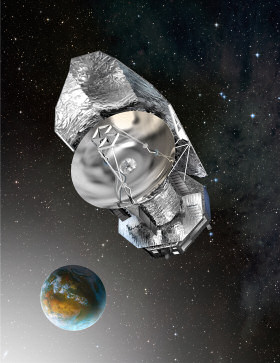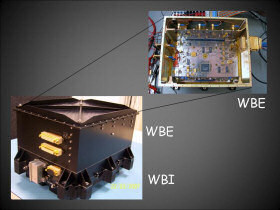Herschel
Space Observatory
 Herschel, short for the "Herschel Space Observatory", is the fourth cornerstone mission in the European Space Agency (ESA) science programme. With a 3.5 m Cassegrain telescope it is becoming the largest space telescope ever launched. The launch of Herschel is planned on 14th May 2009 and will be operated as an observatory facility. Herschel will be the only space observatory to cover the spectral range from far-infrared to submillimetre wavelengths (approximately the 55-672 µm range).
Herschel science payload comprises three instruments: two cameras/medium resolution spectrometers (the Photodetector Array Camera and Spectrometer (PACS), and the Spectral and Photometric Imaging REceiver (SPIRE)) and a very high resolution heterodyne spectrometer (the Heterodyne Instrument for the Far Infrared (HIFI)).
The telescope is named after the British astronomer William Herschel, who in 1800 discovered infrared radiation while studying the Sun. He became famous for discovering Uranus.
Herschel, short for the "Herschel Space Observatory", is the fourth cornerstone mission in the European Space Agency (ESA) science programme. With a 3.5 m Cassegrain telescope it is becoming the largest space telescope ever launched. The launch of Herschel is planned on 14th May 2009 and will be operated as an observatory facility. Herschel will be the only space observatory to cover the spectral range from far-infrared to submillimetre wavelengths (approximately the 55-672 µm range).
Herschel science payload comprises three instruments: two cameras/medium resolution spectrometers (the Photodetector Array Camera and Spectrometer (PACS), and the Spectral and Photometric Imaging REceiver (SPIRE)) and a very high resolution heterodyne spectrometer (the Heterodyne Instrument for the Far Infrared (HIFI)).
The telescope is named after the British astronomer William Herschel, who in 1800 discovered infrared radiation while studying the Sun. He became famous for discovering Uranus.
Science Objectives
The key objetive of Herschel is to study the formation of stars and galaxies, and to investigate the relationship between them. Some examples of the particular investigations of Herschel are:
- Study the formation and evolution of elliptical galaxies and the central bulges in other galaxies during the first third of the Universe’s history
- Reveal the physical and chemical processes in the early and later phases of the stellar’s life
- Investigate how and why stars form from interstellar clouds, and planets form from circumstellar discs
- Study the atmospheres of planets and satellites in our Solar System and of comets
- Determine physical properties of trans-Neptunian objects, the primitive remnants of the planetesimal disk from which the outer planets formed
![[Top]](/images/icons/top.gif)
The Spacecraft
Herschel is 7.5 m high and 4.5 m in diameter, with a mass of approximately 3400 kg at launch. Herschel is designed to perform routine science operations for a minimum of 3 years at around the second Lagrangian point (L2) of the Sun-Earth system (1.5 million km from Earth). In order to achieve its scientific objectives, Herschel’s detectors have to operate at very low and stable temperatures. So the spacecraft cools the detectors close to absolute zero (-273°C).
![[Top]](/images/icons/top.gif)
MPS Contribution
 MPS is member of the Herschel-HIFI Consortium. MPS contributed to the HIFI back-end sub-system which contains the Wide-Band Spectrometer (WBS). The WBS consists of two 4 GHz-wide AOS (Acousto Optical Spectrometers) located in the service module (SVM). The resulting spectral resolution for the HIFI AOS is 1.1 MHz. The WBS has three units: the Wide-Band Spectrometer Optical unit (WBO), the Wide-Band Spectrometer Electronics unit (WBE), and the Wide-Band Spectrometer Intermediate Frequency Processor unit (WBI). MPS provided the WBE and the WBI units. The WBO is provided by the I.Physikalisches Institut of the University of Cologne.
MPS is member of the Herschel-HIFI Consortium. MPS contributed to the HIFI back-end sub-system which contains the Wide-Band Spectrometer (WBS). The WBS consists of two 4 GHz-wide AOS (Acousto Optical Spectrometers) located in the service module (SVM). The resulting spectral resolution for the HIFI AOS is 1.1 MHz. The WBS has three units: the Wide-Band Spectrometer Optical unit (WBO), the Wide-Band Spectrometer Electronics unit (WBE), and the Wide-Band Spectrometer Intermediate Frequency Processor unit (WBI). MPS provided the WBE and the WBI units. The WBO is provided by the I.Physikalisches Institut of the University of Cologne.
![[Top]](/images/icons/top.gif)
The Team
Dr. Paul Hartogh
|
HIFI Co-Investigator, MPS project Scientist, HssO Principal Investigator
(+49 5556 979 342 - hartogh@mps.mpg.de) |
Dr. Christopher Jarchow
|
HIFI Co-Investigator, Instrument Scientist |
Dr. Miriam Rengel
|
HIFI Co-Investigator, HIFI ICC Calibration Scientist |
Dr. Alexander Medvedev
|
HIFI Co-Investigator |
Dr. Thivault Cavalié
|
Post-doctoral Research Fellow, HIFI-Associated Scientist |
Dr. Hideo Sagawa
|
Post-doctoral Research Fellow, HIFI-Associated Scientist |
Dr. Hermann Böhnhardt
|
HIFI-Associated Scientist |
Armando Gonzalez
|
Ph.D. student, HIFI-Affiliated Scientist |
Gerlinde Bierwirth
|
Secretary |
Julia Müller
|
Secretary |
Song Li
|
Engineer (retired) |
Peter Börner
|
Project Manager (retired) |
Eckhard Steinmetz
|
Project Engineer (retired) |
Hartmut Bitterlich
|
Engineer (retired) |
Alexander Loose
|
Engineer (retired) |
Claudius Römer
|
Engineer (retired) |
Markus Monecke
|
Engineer (retired) |
Helmut Schüddekopf
|
Engineer (retired) |
Ulrich Strohmeyer
|
Technician (retired) |
Marianne Krause
|
Technical designer (retired) |
Walter Boogaerts
|
Quality assurance (retired) |
![[Top]](/images/icons/top.gif)
Related Links
